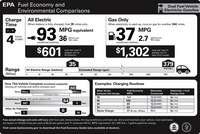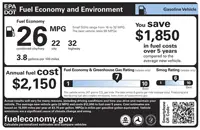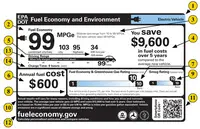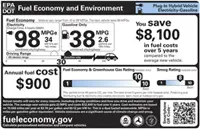New Window Stickers - EPA, DOT Unveil the Next Generation of Fuel Economy Label
FYI: Compare EPA MPG Estimates To Real World Driving
WASHINGTON May 25, 2011; The U.S. Department of Transportation and the U.S. Environmental Protection Agency today are unveiling new fuel economy labels that will help consumers take advantage of the increased efficiency standards achieved under the Obama Administration that will save families money at the pump starting this year. The new labels, which are the most dramatic overhaul to fuel economy labels since the program began more than 30 years ago, will provide more comprehensive fuel efficiency information, including estimated annual fuel costs, savings, as well as information on each vehicle's environmental impact. The new labels underscore the benefits of the historic, bipartisan passenger car and truck fuel economy rule adopted under this administration by the EPA and DOT in 2010.
These improvements will give consumers better, more complete information to consider when purchasing new vehicles that are covered by the increased fuel economy standards. Starting with model year 2013, the improved fuel economy labels will be required to be affixed to all new passenger cars and trucks -- both conventional gasoline powered and "next generation" cars, such as plug-in hybrids and electric vehicles.
Upon taking office, President Obama directed DOT and EPA to prioritize the development of new fuel efficiency and greenhouse gas emissions standards, resulting in the historic standards that will be represented by these new labels. This is the latest step in EPA's and DOT's joint efforts to improve the fuel economy and environmental performance of vehicles and to provide consumers with useful information to inform their purchasing decisions.
The 2010 fuel economy rule, developed with input from major automakers, environmental groups, and the states, will dramatically increase the energy efficiency of cars and trucks built in model years 2012 through 2016, saving 1.8 billion barrels of oil over the life of the program and the average consumer $3,000 in fuel costs.
In July, the Administration plans to finalize the first-ever national fuel economy and greenhouse gas emission standards for commercial trucks, vans and buses built in 2014 to 2018. These standards are expected to save hundreds of millions of barrels of oil over the life of the vehicles covered and promote the development and deployment of alternative fuels, including natural gas. The Administration is also developing the next generation of joint fuel economy/greenhouse gas emission standards for model year 2017-2025 passenger vehicles and expects to announce the proposal in September 2011.
The new labels announced today will help consumers take advantage of the new, more energy efficient fleet, allowing them to save money at the pump. Consumers will see the new labels in showrooms early next year, when 2013 models begin arriving. Automakers may also voluntarily adopt the new labels earlier for model year 2012 vehicles.
"President Obama's work to shape a Clean Cars program is fostering a marketplace of cutting-edge American vehicles that are more fuel efficient than ever before. The EPA and DOT are creating a new generation of fuel economy labels to meet the needs of a new generation of innovative cars," said EPA Administrator Lisa P. Jackson.
"Today's car buyers want the best possible information about which cars on the lot offer the greatest fuel economy and the best environmental performance. The new labels provide comprehensive information to American car buyers, helping them make a choice that will save money at the gas pump and prevent pollution in the air we breathe."
"Our new fuel economy and environmental labels are a win for automobile consumers and for the nation's energy independence," said U.S. Transportation Secretary Ray LaHood. "These labels will provide consumers with up front information about a vehicle's fuel costs and savings so that they can make informed decisions when purchasing a new car."
The new labels will for the first time provide:
- New ways to compare energy use and cost between new-technology cars that use electricity and conventional cars that are gasoline-powered.
- Useful estimates on how much consumers will save or spend on fuel over the next five years compared to the average new vehicle.
- Easy-to-read ratings of how a model compares to all others for smog emissions and emissions of pollution that contribute to climate change.
- An estimate of how much fuel or electricity it takes to drive 100 miles.
- Information on the driving range and charging time of an electric vehicle.
- A QR Code® that will allow users of smartphones to access online information about how various models compare on fuel economy and other environmental and energy factors. This tool will also allow consumers to enter information about their typical commutes and driving behavior in order to get a more precise estimate of fuel costs and savings.
The new labels are required by the Energy Independence and Security Act of 2007.
Basic InformationA New Generation of Labels for a New Generation of Vehicles
New labels required for all 2013 models
In May 2011, the U.S. Environmental Protection Agency (EPA) and the National Highway Traffic Safety Administration (NHTSA) finalized the biggest re-design ever of the fuel economy labels since they were introduced 35 years ago. When the new “fuel economy and environment” labels start to appear in showrooms and online, car shoppers will have more information at their fingertips than ever before like:
- New ways to compare energy use and cost between new-technology cars that use electricity and conventional cars that are gasoline-powered.
- Useful estimates on how much consumers will save or spend on fuel over the next five years compared to the average new vehicle.
- Easy-to-read ratings of how a model compares to all others for smog emissions and emissions of pollution that contribute to climate change.
- An estimate of how much fuel or electricity it takes to drive 100 miles.
- Information on the driving range and charging time of an electric vehicle.
- A QR Code®1 (footnote) that will allow users of smartphones to access online information about how various models compare on fuel economy and other environmental and energy factors.
The new labels will begin appearing in dealer showrooms in 2012 when the 2013 models begin to go on display or earlier if automakers voluntarily adopt the new labels for model year 2012 vehicles.
Click on the labels below to view interactive information about the new labels.
See labels for all vehicle types, including FFVs (flexible fuel vehicles), hydrogen FCVs (hydrogen fuel cell vehicles), and CNG (compressed natural gas) vehicles: All Labels (PDF) (11 pp, 1.4MB, May 2011)
Information on the Current and Historical Fuel Economy Labels
In December 2006, EPA issued updated test methods to determine the fuel economy estimates that appear on the window stickers of all new cars and light trucks sold in the U.S., beginning with 2008 models. For more information about the updated methods, see EPA's Final Rule.
See the label that applies to 2008 through 2012 model year vehicles.
Side by side comparison of 2008-2012 to new 2013 label.
See the label that appeared on vehicles before the 2008 model year.
More information on the new label can be found at www.epa.gov/otaq/carlabel/index.htm and www.nhtsa.gov/fuel-economy.






